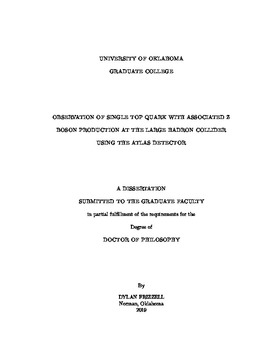| dc.description.abstract | The Standard Model of particle physics is the most well tested theory in modern physics.
It provides the most fundamental description of the natural world using only a handful of particles and their interactions.
At typical energies present at the Earth's surface, the Standard Model allows all of chemistry, electricity, magnetism, light, and even matter itself as we know it.
At higher temperatures interesting things begin to happen: new particles begin to show themselves, forces appear to change, and completely new interactions can emerge.
The Standard Model has successfully described everything we have encountered so far as we explore the dynamics of higher energy systems.
As we continue to push into higher and higher energies the standard model also predicts what is yet to be observed.
It is our job as scientists to search for and measure these predictions in hopes of someday finding something unexpected, and with it an opportunity to learn.
The top-quark is the heaviest known fundamental particle in the Standard Model, and the least studied of all the quarks.
It's production at the Large Hadron Collider in association with a Z boson is a process predicted by the Standard Model that is only recently observable due to the achievement of modern experimental capacity.
This thesis presents the observation and cross section measurement of such a process at the Large Hadron Collider using proton-proton collision data collected by the ATLAS experiment from 2015 to 2018 at a center-of-mass energy of 13 TeV, corresponding to an integrated luminosity of 139 inverse fb.
Only the trilepton decay channel is considered, and events containing three identified charged leptons (electrons and muons)
two or three jets, one of which is identified as originating from a b-quark are selected.
The major backgrounds mimicking this signal are from ttZ, diboson, tt and Z+jets production.
A series of Bayesian neural networks are used to improve the background rejection before extracting and measuring the signal using a binned maximum-likelihood estimator.
The measured cross-section for tllq production including non-resonant dilepton pairs with dilepton invariant mass greater than 30 GeV is 97 ± 13 (stat) ± 7 (syst.) fb.
The statistical significance in favor of this processes' existence is estimated to be 9.1 σ.
This directly matches the expected sensitivity of the analysis and surpasses the common benchmark 5 σ level of significance typically used to claim direct observation. | en_US |
